On the Andes, the snow-capped peaks, the highest active volcanoes in the world, cloud forests with breathtaking biodiversity, colorful markets and Ecuador's colonial heritage are waiting for us.
- Quito and Northern Andes
-
Quito is the starting point for trips into the highlands of the country, the northern Andes with many attraction such as: the colorful Otavalo market, the cloud forest of Mindo, the Antisana reserve and some others.
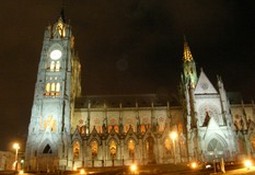 Quito:
Quito:
The capital of Ecuador is probably one of the most beautiful cities in South America. Located at 2850m above sea level and just only 22 km south of the geographic Ecuador, it has magnificent spring weather in a spectacular environment. The view of Quito is dominated by mountains and snowing volcanos. From the architectonic point of view, it preserves a grate amount of colonial treasures and the recent construction of buildings has been severely controlled in the old city since 1978, when it was declared by UNESCO a "World Cultural Heritage Site".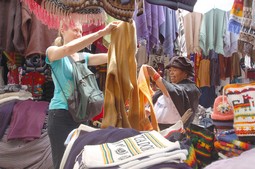 Otavalo:
Otavalo:
The most famous indigenous market in Ecuador is held here. Although the market is bigger on Saturdays, you can visit it any day and find an impressive variety of all kinds of Ecuadorian handcrafts. You may visit the workshops of these local weavers working on back strap and Spanish treadle looms, as well as other artisans at work making felt hats, knitting sweaters or weaving straw mats.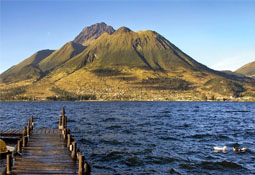 San Pablo Lake:
San Pablo Lake:
Lies 5km from Otavalo. This wonderfull lake is located on the feet of the Imbabura Mountain and refuges on its borders many small indigenous communities. Windsurfing is very popular as well in San Pablo Lake.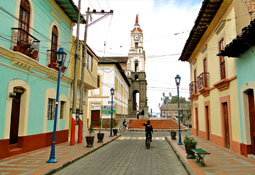 Cotacachi Village:
Cotacachi Village:
A small town nearby Otavalo, its narrow streets is full of stores that sell a great variety of leather goods. This village is one of the safest in Ecuador, enjoy your stay without stress!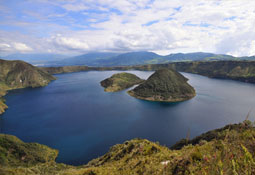 Cuicocha Lake:
Cuicocha Lake:
Located on the south side of Cotacachi Mountain has in its middle two islands surrounded by water. an impressive landscape of deep blue waters surrounded by hills. Take a hike around the lake. You can also take a boat and make a tour around these islands. An experience you won't forget!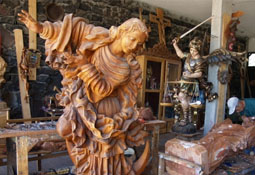 San Antonio de Ibarra:
San Antonio de Ibarra:
Small village where everyone is in the business of carving wooden items. These items are sold in small shops around the village.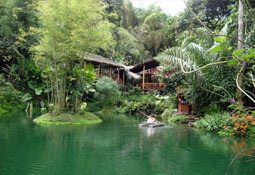 Mindo:
Mindo:
The western slopes of the Pichincha volcano are dressed with a wonderful dense ecosystem: the cloud forest, where is located Mindo. The cloud forest is perhaps the ecosystem that holds the greatest variety of birds and plants in the world. It includes birds and plants from the rain forest, some from the highlands, and others that have evolved in this unique ecosystem. Some of the most impressive bird species of the cloud forest are: Cock of the Rock, an abundance of Hummingbirds, Tanagers, Mountain Toucans, Cotingas, Manakins, among others.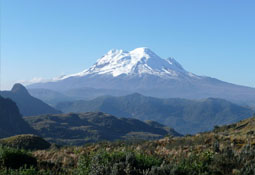 Antisana:
Antisana:
The Antisana volcano is one of the highest active volcanoes in the world and it is surrounded by the 30000 hectares Antisana Ecological Reserve, protected by the Ecuadorian National Park System. One of the biggest attractions is the Micacocha Lake, where lots of locals practice sportive trout fishing. - Central Andes
-
The "Avenue of the Volcanoes" with the snow giants Cotopaxi and Chimborazo, the famous train ride to the "Devil's Nose". A paradise for nature lovers and active people who like to move. Be it on a stroll through the many national parks, a multi-day trekking or climbing the highest mountain on one of Ecuador, the Chimborazo. Baños via the highlands can be perfectly combined with the rain forest.
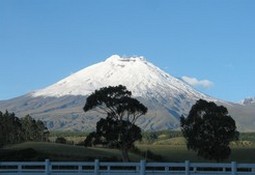 Cotopaxi
Cotopaxi
Tempting route for chancy "andinistas" that do not doubt to the climate and the height in their desire of reaching the summit of the Cotopaxi, the highest active volcano in the world!!!(5896m). he immense plain that surrounds the volcano offers a wonderful landscape with extraordinary geological conditions and numerous flora and fauna. This park is home to dears, pumas, condors, wild horses and llamas.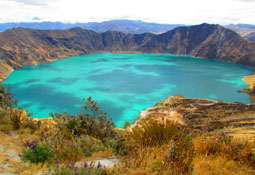 Quilota Lake
Quilota Lake
The Quilotoa is one of the most beautiful places in the Ecuadorian Highland due to it is a lagoon inside a crater, just like Cuicocha. Quilotoa comes from two quichua words, "Quiru" that means tooth, and "Toa" which is queen. The lagoon has elliptical shape and its diameter is about 2 miles. From the superior border to the lagoon there are 1310 ft approximately.
The lagoon is mostly green, but its color varies according to the luminosity, it can change to blue and even yellow. The water has a great mineral composition like sulphur hydrogen and carbonic gas which makes the water not for human consume, however people from the zone use this water for animals. In a sunny day you can see from here some of the Andes Range like the Illinizas to the north.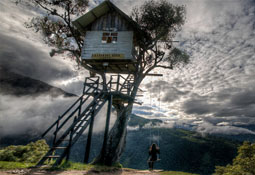 Baños
Baños
Baños is a natural sanctuary, where tranquility and spirituality flow. It is the perfect setting for meditation and relaxation of the soul. Baños de Agua Santa is refugee for more than 60 waterfalls, among which is waterfall Pailon del Diablo. Baños is unique and suitable for the practice of several adventure sports such as: rafting, kayaking, mountain biking, four-wheel driving, among others. Baños, called "piece of Heaven" by its inhabitants, grows every day with new ideas and new alternatives of entertainment.
The active Tungurahua volcano of 16.450 ft of height offers beautiful scenery and has a wide variety of flora and fauna at its feet.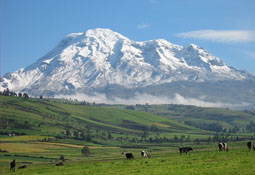 Chimborazo
Chimborazo
Chimborazo, an extinct volcano, is the highest peak in Ecuador. Its towering ice-capped peak is awesome when seen from the Pacific, and in 1745, it was believed to be the highest mountain in the world, a belief which was sustained until the discovery of Dhaulagiri (8167m/26,794 ft.) in 1808.
In fact, Chimborazo still lays claim to being the highest mountain in the world, if measured from the center of the Earth. It is positioned one degree south of the equator, where the diameter of the earth is greatest, and Chimborazo is over 6,384 kilometers (3,967 miles) from the earth's center, compared to only 6,382 kilometers (3,965 miles) for Mount Everest.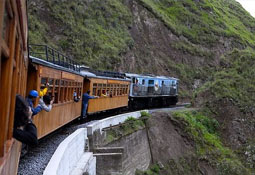 The Devil's nose train ride
The Devil's nose train ride
Thirty kilometers into the ascent of the towering western range, 130 kilometers east of Guayaquil, the railway snakes up a mountain known as El Nariz del Diablo (The Devil's Nose). This nearly vertical wall of rock was the greatest natural obstacle engineers encountered during construction of the Southern Railway, and one of a string of blunders that nearly smothered the dream of connecting Guayaquil and Quito by rail.
Today, a one-percent grade, or an incline rising one meter in 100 meters of horizontal distance, is considered steep. Moreover, inclines and curves in the track, especially ones as dramatic as those of the Devil's Nose, limit the speed of trains and the size of the loads they can carry. Whenever possible tracks follow topographical contours or the contours are smoothed out or tunneled through. At the Devil's Nose, engineers ruled out tunneling through the mountain and decided that they must either go up it or around. They chose up. This decision made sense in 1900 but unfortunately it has precluded the use of the Southern Railway for use as a freight or efficient passenger line - Southern Andes
-
The Inca ruins Ingapirca, Cuenca, the Athens of Ecuador And the coast is not far off. From Cuenca Guayaquil reach a varied day trip with a stop in the beautiful Cajas National Park.
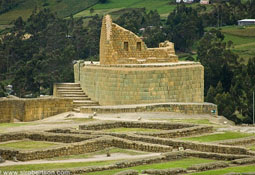 Ingapirca Inca Ruins
Ingapirca Inca Ruins
These vestiges are the most important architectural legacy of the Incas in Ecuador. Ingapirca means "Incas stone wall". The vestiges rise dramatically above beautiful valleys. On the way to Ingapirca are the towns of Azogues, with its lovely church and Saturday straw market; and Biblian, crowned with an astonishing cathedral cut into the rock.
It is believed today that Ingapirca was both a religious and administrative center, as well as a fortress. The Incas built the complex on top of an old Cañari settlement.
The vast archeological complex includes a roofless fortification, courtyards, terraces, temples, houses and a "castle", possibly the "Temple of the Sun" Cuenca
Cuenca
Cuenca, as the majority of the main cities of Ecuador, developed a history with a mixture of the native indigenous combined with the Spanish heritage that was brought along by the European conquerors. Cuenca is located in a valley high up in the mountains surrounded by other smaller valleys of warmer climate.It has produced great artists, poets and writers in its unique ambiance. The people of Cuenca are conservative, religious, and proud of their city, traditions and culture.
Cuenca has a flavor and a character of its own. It is not only displays extraordinary works of art in its museums, churches and convents, but also its unique architecture in the midst of which you will be enchanted.
